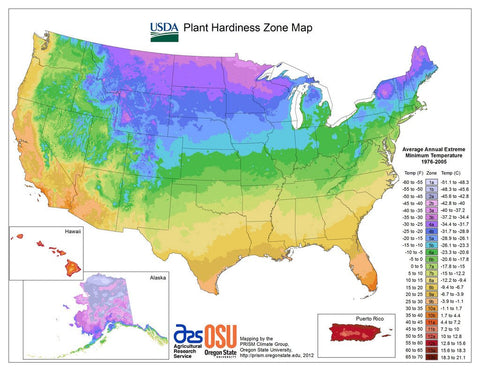Whether you’re an experienced gardener or a brand-spankin’ new one, you’ve likely seen references to “growing zones.” If you’re looking at plant tags or labels, or reading growing information on a plant or garden website like Easy to Grow Bulbs, you’ll see things like “Zones 5-9” or “Hardy to Zone 6,” or “Hardiness: Zones 7-9.” You’ll even hear gardeners asking on social media, “What’s your growing zone?” (It might be the new get-to-know-you pick-up line if you’re a garden geek.)
Knowing what zone you garden in is crucial to selecting plants that will grow well where you live — if you love agaves and live in an area where you have snow on the ground for 4 months, you’ll quickly learn that agaves don’t particularly care for that type of thing. So let’s take a look at growing zones, as well as a few other things that will help you choose the best plants and bulbs for your garden! It involves some charts, a map, and a few numbers, and they will all help you create your best garden with plants that thrive where you live.
What are Growing/Hardiness Zones and Why are They Important?
First, while “hardiness zone” is the official phrase, “growing zone” means the same thing, and most gardeners use them interchangeably. The United States has a system of classifying the country into 11 zones, with each zone also subdivided into a and b (Zone 6a and 6b, for example), depending upon the climate and average minimum temperatures in that area. Each zone’s minimum average winter temperature is 10 degrees colder than the zone after it. For example, Zone 5a’s minimum average temperature is -20 to -15 (F), with Zone 6a’s average being -10 to -5 (F).
You can find your zone by going to the USDA website and entering your zip code above the map. Now you know what your zone is, you can look for that information when you’re plant shopping to see if the plant you’d like to grow is compatible with your area’s climate.

How Does This Apply to Bulb Gardening?
Bulbs are like any other plant with their own set of preferences. And each type of bulb has different requirements as well. When you’re ordering bulbs, you want to pay attention to both the average low for your area as well as the average high, because many bulbs both require cold winter temperatures in order to bloom and other bulbs simply can’t stand the heat of very hot summers.
In the previous section, we talked about hardiness/growing zones, which tell you your area’s minimum average winter temperature — so we’ve got that one covered already. But with growing bulbs, it’s also important to know your area’s average summer high temperature as well — and for that, we’ll consult the American Horticulture Society’s Plant Heat Zone Map. Once you know your Hardiness Zone, simply pop over to the Plant Heat Zone Map, locate your zone on the chart, and you’ll find your area’s average number of days per year when the temperature is over 86 degrees F.
So let’s say you garden in Cincinnati, OH, and you want to plant bulbs. What are your steps?
- Determine what your Hardiness Zone is by going to the USDA website and popping in your zip code. You’ll find that Cincinnati is in Hardiness Zone 6a, meaning your average minimum winter temps are -10 to -5 F.
- Determine your average number of hot days by going to the Plant Heat Zone map and finding your Hardiness Zone on the chart. You’ll see that Cincinnati has an average of 45 – 60 days above 86 degrees F.
- Now you know your average lows and highs — hop over to Easy to Grow Bulbs and start shopping! In each of our plant descriptions, you will find information about the zones that are suitable for that particular plant.

What Other Factors Impact How a Plant Thrives?
While growing zones and heat zones are crucial factors when selecting bulbs, there are other considerations to take into account, too. But don’t let any of this overwhelm you — once you get a little more experience under your belt, these things will be second nature to you. Until then, when you fall in love with flowering bulbs like our Freesia Cottage Garden Collection (good choice, BTW), here is some additional information to look for and be aware of:
-
How much rainfall your area receives: The majority of bulbs like soil that is well-drained, and while some may like a little more soil moisture, others are more drought tolerant (hello, Eremurus!). So if your area receives a good deal of annual rainfall, you’ll want to plan your bulb selection accordingly.
-
How much sun your own garden gets: Full sun? Try Italian Ranunculus Success Felicidade. Got a little shade? Spanish Bluebells might be your thing.
-
How well the soil in your garden drains: Again, most bulbs do best in soil that is well drained, meaning the water moves through the soil without bogging it down. Very wet soil will rot bulbs out — and you know what they say about rotted bulbs! Well, they may not say anything, actually, but it doesn’t bode well for your garden.
- How humid your area is: Live by the coast and the humidity means lots of frizzy hair days? There are bulbs for you — like the Gulf Coast Daffodil Collection!

